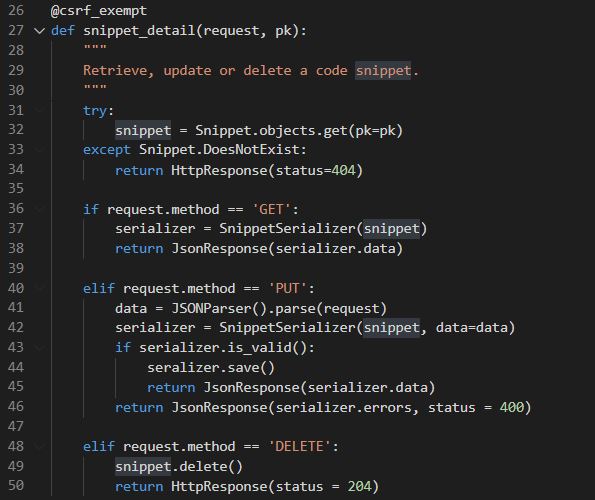Tutorial 2: Requests and Responses
https://www.django-rest-framework.org/tutorial/2-requests-and-responses/
1. Request Objects
REST framework introduces a Request object that extends the regular HttpRequest, and provides more flexible request parsing.
The core functionality of the Request object is the request.data attribute, which is similar to request.POST, but more useful for working with Web APIs.
request.POST # Only handles form data. Only works for 'POST' method.
request.data # Handles arbitrary data. Works for 'POST', 'PUT' and 'PATCH' methods.👉reqest.POST는 form(POST 방식)으로 전달된 data만 다룰 수 있다.
👉request.data는 POST, PUT, PATCH 방식으로 전달된 데이터를 모두 다룰 수 있다.
2. Response Objects
REST framework also introduces a Response object, which is a type of TemplateResponse that takes unrendered content and uses content negotiation to determine the correct content type to return to the client.
return Response(data) # Renders to content type as requested by the client.3. Status Codes
Using numeric HTTP status codes in your views doesn't always make for obvious reading, and it's easy to not notice if you get an error code wrong. REST framework provides more explicit identifiers for each status code, such as HTTP_400_BAD_REQUEST in the status module. It's a good idea to use these throughout rather than using numeric identifiers.
👉 status code를 숫자로 나타내기보다는 status 모듈을 사용하여 더 명확하게 나타내자
4. Wrapping API views
REST framework provides two wrappers you can use to write API views.
- The
@api_viewdecorator for working with function based views. - The
APIViewclass for working with class-based views.
These wrappers provide a few bits of functionality such as making sure you receive Request instances in your view, and adding context to Response objects so that content negotiation can be performed.
The wrappers also provide behaviour such as returning 405 Method Not Allowed responses when appropriate, and handling any ParseError exceptions that occur when accessing request.data with malformed input.
👉 API view 작성 시 용이성을 높여주는 @api_view, APIView가 있다.
5. Pulling it all together
🔽이전 코드 - tutorial1까지의 코드🔽
🔽수정된 코드🔽Our instance view is an improvement over the previous example. It's a little more concise, and the code now feels very similar to if we were working with the Forms API. We're also using named status codes, which makes the response meanings more obvious.
This should all feel very familiar - it is not a lot different from working with regular Django views.
Notice that we're no longer explicitly tying our requests or responses to a given content type. request.data can handle incoming json requests, but it can also handle other formats. Similarly we're returning response objects with data, but allowing REST framework to render the response into the correct content type for us.
6. Adding optional format suffixes to our URLs
To take advantage of the fact that our responses are no longer hardwired to a single content type let's add support for format suffixes to our API endpoints. Using format suffixes gives us URLs that explicitly refer to a given format, and means our API will be able to handle URLs such as http://example.com/api/items/4.json.

7. How's it looking?
8. Browsability
Because the API chooses the content type of the response based on the client request, it will, by default, return an HTML-formatted representation of the resource when that resource is requested by a web browser. This allows for the API to return a fully web-browsable HTML representation.
Having a web-browsable API is a huge usability win, and makes developing and using your API much easier. It also dramatically lowers the barrier-to-entry for other developers wanting to inspect and work with your API.
See the browsable api topic for more information about the browsable API feature and how to customize it.

